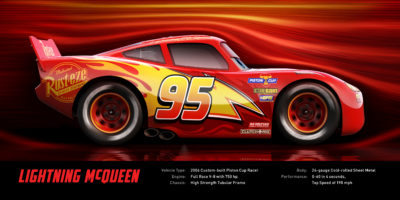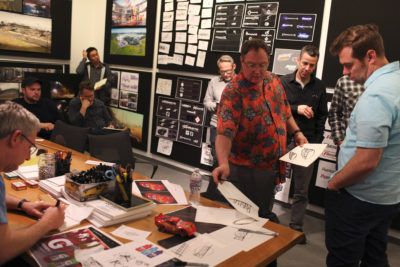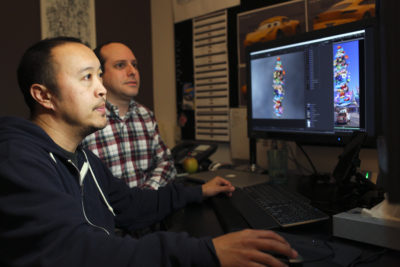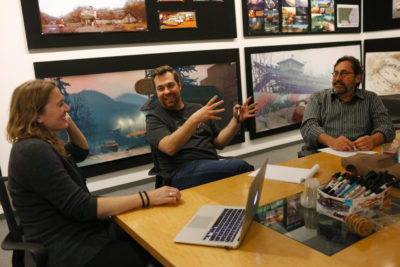 Last November, audiences were excited when the teaser trailer for Cars 3 debuted. The preview begins with Lightning McQueen doing what he does best, racing. But the tone quickly turns melancholy as he flies over the camera in slow motion, rolling, wrecking, his spoiler falling off. In March, I got the chance to hear from some of the creative team at Pixar to see and learn more about Cars 3 and how audiences will reconnect with Lightning McQueen on June 16th.
Last November, audiences were excited when the teaser trailer for Cars 3 debuted. The preview begins with Lightning McQueen doing what he does best, racing. But the tone quickly turns melancholy as he flies over the camera in slow motion, rolling, wrecking, his spoiler falling off. In March, I got the chance to hear from some of the creative team at Pixar to see and learn more about Cars 3 and how audiences will reconnect with Lightning McQueen on June 16th.
“We had one thing we wanted to say,” explains Director Brian Fee. “We wanted to come right out of the gate and say ‘This is probably not the Cars movie you’re expecting.’ Because the Cars movie we’re making is probably not the Cars movie you’re expecting.”
From what I saw of Cars 3, it feels like a return to the tone of the original film. “Cars was Lightning McQueen’s movie, Cars 2 was Mater’s movie and it asked to be a different kind of film because of who that lead was,” says Story Supervisor Scott Morse. “But both of those films really helped us with Cars 3 because they established who Lightning McQueen was at the top of his game. He’s a world champion and nothing can touch him, he’s immortal in his own mind. What could go wrong? That was the problem we were presented with to figure out, but it gave us this really interesting way to open Cars 3.”
 “We wanted to make sure that we created a believable and authentic dilemma for him,” recalls writer Mike Rich. “We started to explore this concept of the aging athlete. If you look at Cars 3, it’s actually the third act of the Cars story. When McQueen was young, he was just that. He was young, he was brash, he was cocky, he didn’t need anybody to tell him anything about anything, he had the answers and his respect for the sport of racing was really kind of limited to what was two feet in front of him right now. And so we wanted to tap into that because he had become a different character, he had become an older character.”
“We wanted to make sure that we created a believable and authentic dilemma for him,” recalls writer Mike Rich. “We started to explore this concept of the aging athlete. If you look at Cars 3, it’s actually the third act of the Cars story. When McQueen was young, he was just that. He was young, he was brash, he was cocky, he didn’t need anybody to tell him anything about anything, he had the answers and his respect for the sport of racing was really kind of limited to what was two feet in front of him right now. And so we wanted to tap into that because he had become a different character, he had become an older character.”
Now that McQueen is older, wiser, and dealing with the effects of aging, the animation team had to approach the character differently. “McQueen is a little bit older, he’s not as agile, he’s stiff, he’s tense, his body rattles a lot more,” explains Supervising Animator Jude Brownbill. “He’s basically been challenged and he’s desperate to avoid failure, so one of the things we tried to be wary of was how can we show a difference between McQueen from Cars and this new phase of his life. McQueen is a character that the world knows and loves and we needed to respect that, the way that he looks and the way that he acts should be the same. And Owen Wilson continues to add his charm and charisma to the voice of McQueen. But now he’s bringing these extra layers of uncertainty, vulnerability and his renewed determination to succeed. But whether he’s young McQueen or veteran McQueen, he’s our baseline and he’s where we compare all the other characters to.”
 It wasn’t just the animators who had to approach McQueen from a new angle, but also the technical teams that give the animators the tools to make the film. Since Cars 3 is using the most advanced rendering technology possible, McQueen has a few upgrades that audiences probably wouldn’t notice at first glance. “You see all this detail from the license plate to the logo to the diffuser, even the headlights,” explains Character Supervisor Michael Comet. “Our software for Cars 3 is so advanced that we have to model actual deflectors and bulbs and lenses so that the light actually bounces through our lights correctly and behaves accurately. We didn’t have to do this in our previous films, so we actually had to upgrade our old characters as well up to this standard… What’s really interesting with Cars 3 is that our technology has advanced so far that everything responds very accurately. So for example, we have shots in the film where we’ve had to animate characters that are off-screen simply because they’re being reflected in McQueen.”
It wasn’t just the animators who had to approach McQueen from a new angle, but also the technical teams that give the animators the tools to make the film. Since Cars 3 is using the most advanced rendering technology possible, McQueen has a few upgrades that audiences probably wouldn’t notice at first glance. “You see all this detail from the license plate to the logo to the diffuser, even the headlights,” explains Character Supervisor Michael Comet. “Our software for Cars 3 is so advanced that we have to model actual deflectors and bulbs and lenses so that the light actually bounces through our lights correctly and behaves accurately. We didn’t have to do this in our previous films, so we actually had to upgrade our old characters as well up to this standard… What’s really interesting with Cars 3 is that our technology has advanced so far that everything responds very accurately. So for example, we have shots in the film where we’ve had to animate characters that are off-screen simply because they’re being reflected in McQueen.”
McQueen also gets a 2017 upgrade with respect to his “stickers,” as Sally affectionately calls him in the original film. “We have a team of shading and painting artists that can create different types of materials and we can control things like color, shininess, reflectivity,” Comet continues. “So we would then take those materials and apply them to McQueen. With the graphics on the side, he has a wrap like cars do in racing. We get art from the art department and that’s applied sort of like you would apply a decal on a toy model. We’re doing that in the computer virtually.”
 Lightning McQueen’s memories of Doc Hudson become very important in Cars 3, and some never before heard dialogue from the first film has found its way into this one. “There was so much great Paul Newman stuff,” Writer Kiel Murray adds. “I remember because I was on that film, they kept it rolling all the time, even when he was just telling stories and wasn’t recording, so it was really just a matter of listening to it all… Anytime you hear his voice, it’s just good. I feel like it just cuts through. So that was one of my goals on this film. It was like ‘Can we have more? Can someone listen to all of it?’ People sat, editors wrote up everything… there was a lot of great stuff to choose from.”
Lightning McQueen’s memories of Doc Hudson become very important in Cars 3, and some never before heard dialogue from the first film has found its way into this one. “There was so much great Paul Newman stuff,” Writer Kiel Murray adds. “I remember because I was on that film, they kept it rolling all the time, even when he was just telling stories and wasn’t recording, so it was really just a matter of listening to it all… Anytime you hear his voice, it’s just good. I feel like it just cuts through. So that was one of my goals on this film. It was like ‘Can we have more? Can someone listen to all of it?’ People sat, editors wrote up everything… there was a lot of great stuff to choose from.”
“We just wanted to make it emotional,” explains Writer Bob Peterson. “Make this an emotional, meaningful film. If it conjures up some of the Americana, the nostalgia, the friendship and the community of the first one, that’s great.” From what I’ve seen, I can attest to the fact that it certainly has that potential. Next in this series, we will take a look at Lightning McQueen’s new adversary, Jackson Storm.
